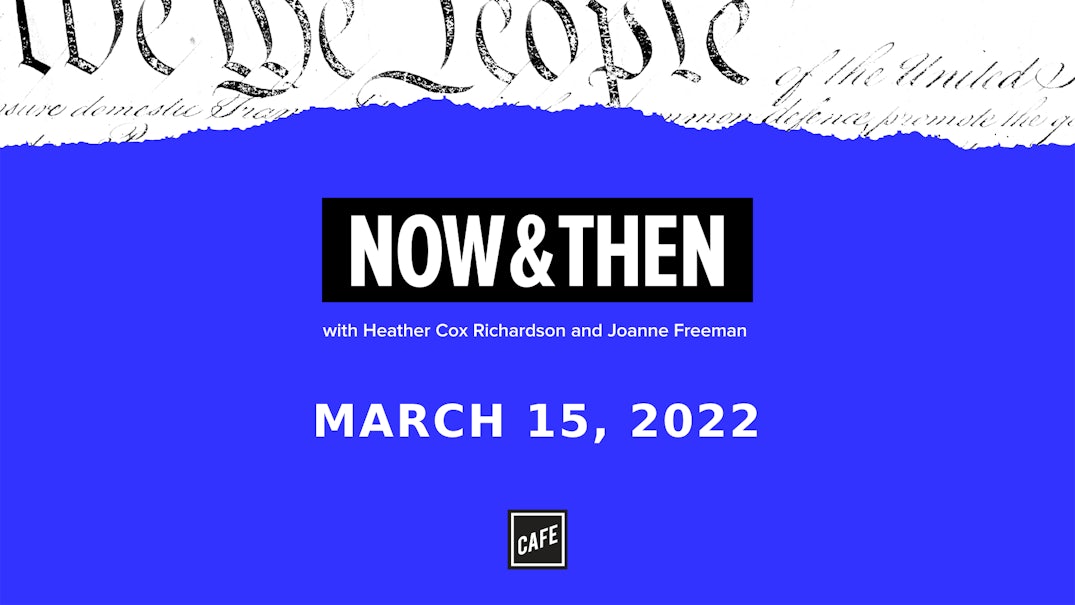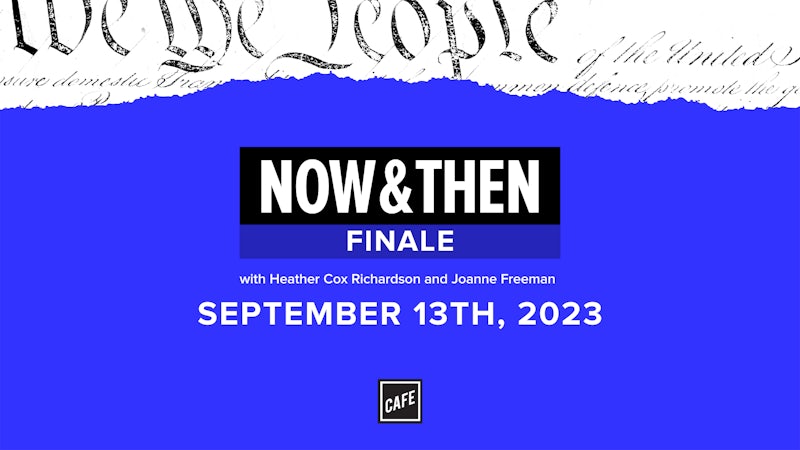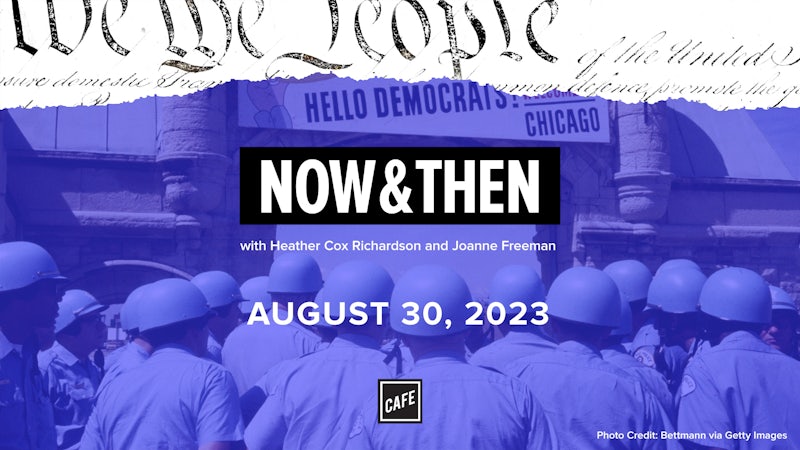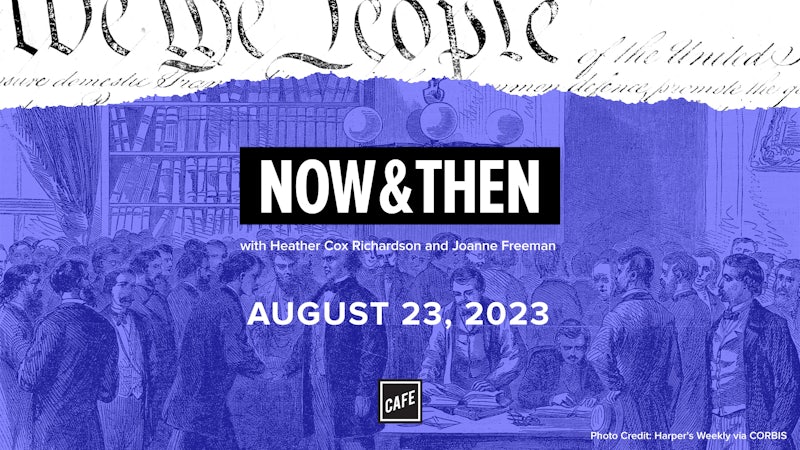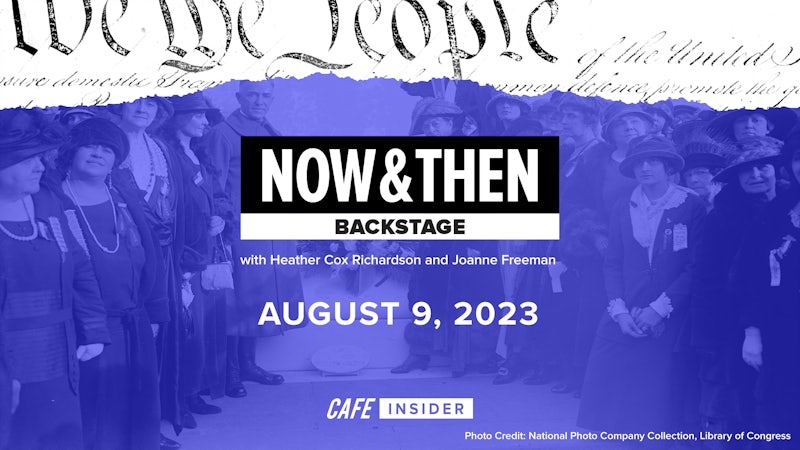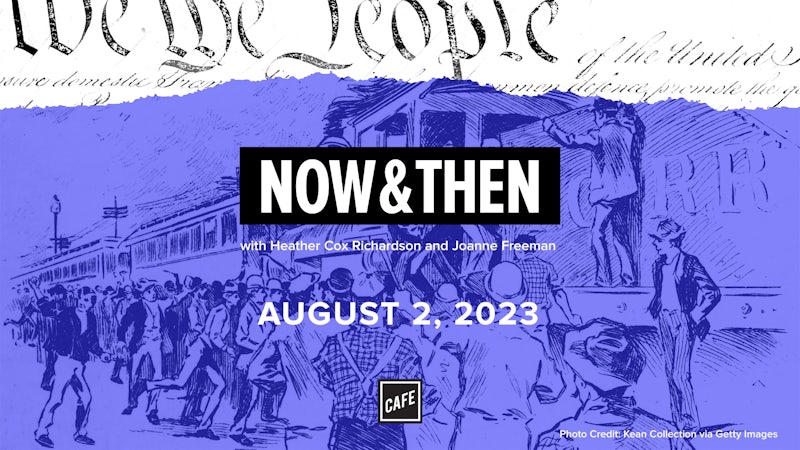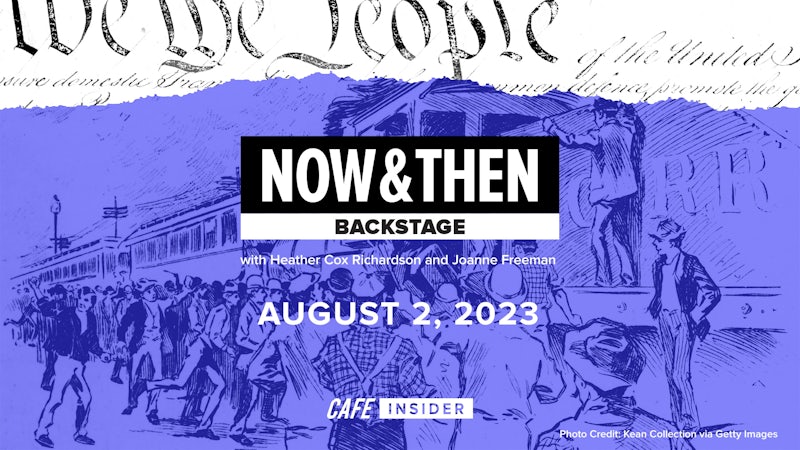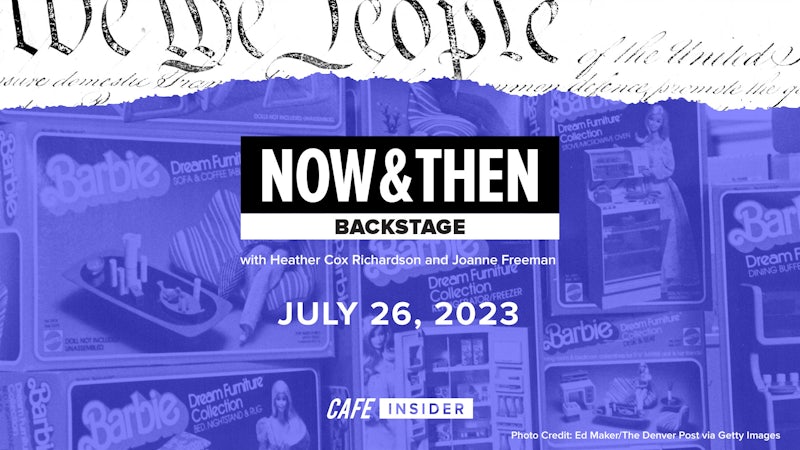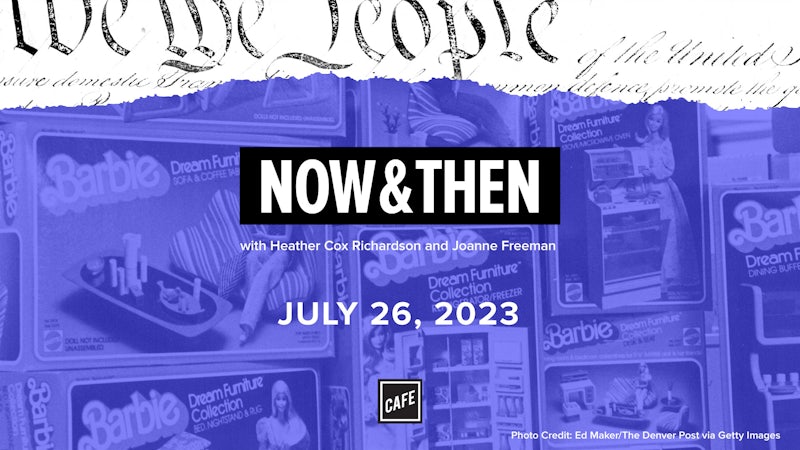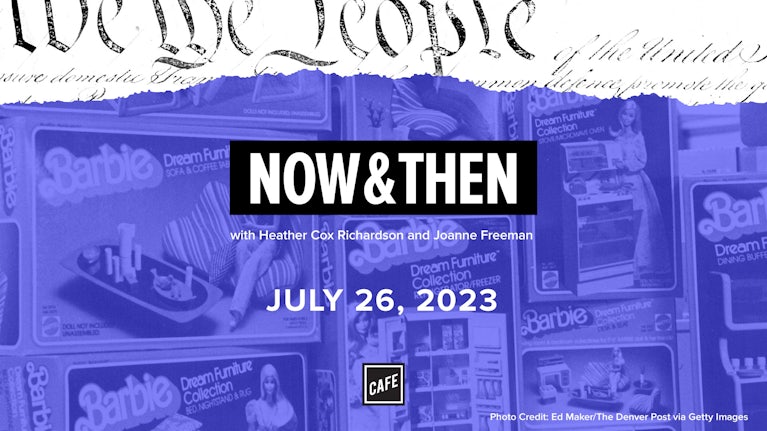Heather Cox Richardson:
From CAFE and the Vox Media Podcast Network, this is Now & Then. I’m Heather Cox Richardson.
Joanne Freeman:
And I’m Joanne Freeman. Today, we’re going to talk about a topic that was inspired by, I suppose as so many conversations are being inspired by today, the Russian invasion of Ukraine. What struck Heather and I last week when we began thinking about this episode was the way in which there are so many stories coming out of Ukraine about the fighting of the war that are centered on women, lone women, individual women, like the woman who allegedly threw a jar of cucumbers, which apparently is actually a jar of tomatoes, at a drone and brought a drone down, or the older woman who gave sunflower seeds to Russian soldiers so that when they died in Ukraine, the Ukrainian national flower, sunflowers, would grow up around their bodies. At some point, there was a story about a woman, you could see her, I think on video, throwing Molotov cocktails.
We’re seeing lots of footage about a lot of different aspects of the war. Some of the most claimed or noticed or noteworthy, to many people, images that we’re getting out of Ukraine have to do with these individual women standing up in front of Russian soldiers in one way or another or in front of Russian attacks of one kind or another and fighting back. And there’s a big response to that in the United States, particularly, I think also an emotional kind of response for what that represents.
And in a sense, that’s what we want to address today is the topic of women in battle. Not just women and war, but women in battle and what that suggests about gender and the different roles that gender plays in the United States at those moments and along bigger lines, what that says about America and society. What does it show about where we are at those given moments in time?
Heather Cox Richardson:
Well, and what’s interesting about the woman with the jar of tomatoes and the women who have been singled out as individuals is that they are celebrated in America to the point that even Stephen Colbert did a monologue about how, ooh, you don’t want to piss off the moms.
Stephen Colbert:
Putin, you done messed up now. You made the moms mad. You made mom mad. You can’t make mom mad. That is two things everybody knows. Everybody knows, don’t make moms mad. Moms were built for conflict. They can find anything. They can eat dinner under 20 seconds. And they know exactly what you’re doing, even if you’re upstairs and completely silent. If they use Putin’s middle name, it is over. Vladimir Vladimirovich Putin, you get down here right now, young man.
Heather Cox Richardson:
You know, this is something extraordinary to have mothers and women in battle. But in fact, there are women in the Ukraine military. There’s about 32,000 of them who serve in the military. That’s about 15% of the total military personnel, and they’re not getting into the news as ordinary soldiers. Women are taking on a role as being outside that normal, military procedure, at least to the degree that they’re being celebrated in popular media. I can’t get away from that because the examples that we will be talking about are things to make your daughters proud and follow in their footsteps at the same time that they’re outside the actual roles of women during wartime. And they really don’t challenge gender roles across the society.
So we can look at the woman throwing her favorite tomatoes at a drone and talk about what it means to have women involved in a war that way, but not so much say, hey, 15% of the fighting force is women. And this shouldn’t be really a surprise, because why would we think that men love their country more than women do? So we don’t really challenge the gender norms by looking at these people. And yet, they embody something about our society when we do say, “Hey, this is somebody we really think is important to lionize in popular culture.”
Joanne Freeman:
And along similar lines, I think what this is going to highlight is that often there are women acting in what are essentially traditional combat roles that are simply not being recognized as such. They’re not formally enlisted or they’re not granted pensions. They’re serving, they’re fighting, they’re risking, but they’re not seen as part of the fighting package that is considered a country at war. A phenomenon that happens during wartime really isn’t recognized as such. And instead, we focus on the individuals.
Heather Cox Richardson:
And we can maybe unpack a little bit more of that, because there’s so much there about the line between reality and myth and what people identify with. But I really want to start here with the American Revolution, because there are so many female figures in American Revolution that have been handed down all the way to the present. Even though when you started talking about them, I’m like, “Wait, wait, I know that person. I think she did something cool.” And now you tell me that one of them isn’t even real.
Joanne Freeman:
Indeed. And the first thing I should say about women in the revolution is, I think as we’re going to find so often in some of the people and topics we’re talking about today, women were involved in the war effort in a lot of ways. And women were seen as belonging in the war effort, doing things like making saltpeter or sewing uniforms or doing things that were considered to be part of the home front, right? That were not considered to be part of the field of battle, although there were nurses and there were laundresses and any number of other kinds of people who were walking and traveling with the troops and serving in a number of capacities, but fighting was another matter. At least, that’s what it was seen at the time and forever after actually has been.
So yeah, Molly Pitcher is the name that, if some people have a vague sense of a woman somehow having something to do with fighting in the American Revolution, that’s often a name that they know. When I teach my American Revolution course, I assume that students assume that Paul Revere, all by himself, rode all over the place saying, “The British are coming, the British are coming.” Which, of course, makes no sense because at that point he was British too. But also, that Molly Pitcher is one of the names that they have a vague sense Molly Pitcher is out there. There was no single Molly Pitcher.
Heather Cox Richardson:
That’s it, I’m out of here.
Joanne Freeman:
I’m so sorry. We have other good stuff in the rest of the episode that will be more than you ever knew before. I just have to take away Molly Pitcher. I’m so sorry. There was a woman named Mary Hays who basically was serving water to people and was very cool under fire. And I think a cannonball went between her legs and grabbed some of the skirt as it passed by and she kept doing what she was doing. So she was brave under fire.
Then there was a woman named Margaret Corbin who was by her husband’s side on the battlefield. He was firing a cannon. He was killed and she took his place and continued firing that cannon and ultimately was given a military pension by the Continental Congress, which was noteworthy. So she was actually recognized for what she did.
There’s also a woman, I think that she also falls into the category of, I think I know this name, but I’m not sure who she is or what she does, a person named Deborah Sampson who fought as a man during the war under the name Robert Shurtleff and fought as a man. Only was found out when injured and a doctor discovered that this person who was a man was actually a woman. In that case, Robert/Deborah was fighting in combat like any other man and afterwards had to fight to get a pension because, of course, she wasn’t a soldier along conventional lines. So she was not recognized in conventional ways for what she did, much like other women engaged in one way or another in combat during a war effort.
She ended up going on a national lecture tour. She’s one of the first women in America to go on a national lecture tour. She got a little bit of a pension because of that. Because as in so many cases, she attracted enough attention that there was some embarrassment and she was given some money. But again, she was fighting and didn’t get any commentary as a male soldier fighting. And then even when she was revealed, didn’t really get recognition for that.
Heather Cox Richardson:
Well, I find this incredibly interesting because these are women who did participate, of course, but they are all exceptions to what was a much larger rule of the home front turning out to support this war. And of the women who were moving along with Washington’s army, either as laundresses or as sex workers or as cooks or as wives or as nurses or as… Didn’t they bury the dead as well?
Joanne Freeman:
Some did.
Heather Cox Richardson:
So I want to actually kind of push you a little bit on this, Joanne, because we know that once you have fought a war that is theoretically for liberty and justice for all, I’m sorry, I made that part up, but you know what I’m talking about, that everybody should be included. And women put a big effort into being included in the new republic. And historians led by the great Linda Kerber have pointed out how women get included in the republican dream by being mothers, the republican motherhood.
Would you argue that by sort of pulling these women out and saying, “Oh look, aren’t they good American patriots,” but they’re really not like everybody else. They’re something different? They only what they did because it was war time. They didn’t really challenge gender norms. That you can both say, “Hey, look, women are part of this society and we really care about them and they’re going to be good little wives and mothers.” But at the same time, we’re actually not going to create a new kind of idea that women are actually participating in the war effort as essentially being the commissary and the nursing staff and all that.
Joanne Freeman:
Regardless of whether they were allowed or not allowed in or where they were being pushed or pulled or how they were considered to be in an appropriate place or not, they gained a sense of themselves as political actors. And for some women, that was boycotting goods for the sake of the revolution. For other women, that was making uniforms. For other women, that was nursing troops.
What happens in the end of the war is that you have a politicized female population that feels that they have a right to engage in that kind of behavior. And the idea of being a republican mother is a really crafty of way of saying, “Well, yeah, women, you’re really important because what you need to do is train the next generation to be good, small-r republicans, right? To understand real American values, not those scary old world aristocratic values, but to train Americans to be good Americans and it’s vital and we can’t survive without you. And you can do that at home.” So you know, it’s a box of one kind. It’s an empowered box of one kind, but it is a role being assigned.
It’s important, so it wasn’t a mask to just shove women back into a domestic sphere. It was seen as important. And women’s education was really addressed in an important way in the late 18th century for that reason in the United States. But yes, people were comfortable with that role as to how they understood American society. And the question and my use of the word box actually makes me think of something that we might want to come back to as we talk today, Heather. And that is, I think in a lot of ways, wars, they rely on seeing the world as a series of boxes, right?
When you’re in a war, you have friends and enemies. You have us and them. You have usually, unless the war’s in your own country, you have the battlefield and the home front. You have good guys and bad guys. And I think traditionally speaking, although it’s not true in fact, in thought you end up having men who are soldiers and are powerful on the battlefield defending the home front. There are boxes where people fit.
There are a lot of people who aren’t in those boxes, but I think particularly during time of war, that becomes something that’s even harder than it typically is to grapple with. I think republican motherhood is a nice way of sort of incorporating a box into the idea of patriotism and an activist kind of woman role in society, but there’s not always that kind of a role, I think, that’s found.
Heather Cox Richardson:
I might push back on that. Because of course, it’s during war time that we get new roles in a huge way for women and people of color, during the Civil War, for example, World War I and World War II.
Joanne Freeman:
But my question then is, what happens after that? Because we got new roles during the revolution, too.
Heather Cox Richardson:
There’s certainly pressure to go back to the way things were and to recreate a mythology of what America is supposed to, and that’s in air quotes, look like. And it rarely looks like, in the long term, the revolutions that those wars have created within American society.
I do love the fact that Molly Pitcher became such a symbol of the American Revolution that Calvin Coolidge in 1926 actually said, “Who has not heard of Molly Pitcher, whose heroic services at the Battle of Monmouth helped the sorely tried army of George Washington? We have been told of the unselfish devotion of the women who gave their own warm garments to fashion clothing for the suffering Continental Army during that bitter winter at Valley Forge. The burdens of the war were not all born by the men.” But there you go. It’s absolutely just a reinforcement of these traditional gender norms by 1926.
Joanne Freeman:
So Coolidge, he’s basically saying, “Hey, who’s not heard of this imaginary woman who really didn’t exist? Yay for her. And then also, women gave up their warm clothing.”
Heather Cox Richardson:
Yeah. And he’s really setting up this mythological figure that says, “She fought for the revolution, but she didn’t do it in any way that challenges any of the 1920s gender norms,” which is interesting coming from the 1920s when there was so much else going on with women wearing flapper dresses and changing so many of the norms, bobbing their hair and smoking cigarettes and drinking alcohol, gasp.
Joanne Freeman:
So on the home front, they’re pretty radical.
Heather Cox Richardson:
Yeah. It says something about why and in what circumstances you would want to reinforce those images. And that’s actually a wonderful segue to one of our famous figures in the Civil War and one that was appreciated far less during her time, and she called people out for that. And that, of course, is Harriet Tubman.
Now, Harriet Tubman was an enslaved woman who escaped slavery in 1849. And after she escaped, she led more than 70 enslaved people to freedom in the north along the root of the Underground Railroad. And she did that until just before the Civil War broke out. Once the war began, the governor of Massachusetts, John Andrew, who was an abolitionist, asked her to start working for the Union Army. And she did in fact spend the early years of the war trying to help with the logistics of caring for and feeding the enormous number of enslaved people who fled out of the South into the territory that was controlled by the Union.
Then, though, in spring of 1863, the army actually turned to Tubman to organize a scouting service. She was going to lead a small group of Black Americans deep into the enemy’s territory and to come back with information about Confederate movements. Now, this is actually a spying run. If they are discovered, they will, of course, be enslaved again, and it is a really interesting intelligence mission in that the army recognizes that enslaved people or Black Americans in the South have really good systems of intelligence where they know where things are going to be moving and who is moving where and where the roads are and all sorts of things that you would know if you lived in an area. They want access to that and they recognize that it’s going to be easier for enslaved people to get it than for army spies themselves.
Joanne Freeman:
I want to highlight the fact that I think a lot of people know Harriet Tubman for leading enslaved people to freedom through the Underground Railroad, and that’s what they know her for. They don’t necessarily know her for all of the things that you are now showing us here, which is the ways that increasingly, as the Civil War goes on, she becomes more and more engaged in active combat service, first nursing, then spying, and then even more. So that even though she is a historical figure who gets recognition and who is seen as extraordinarily brave and understood to be a fighter, that people don’t necessarily, I think, know of her role in combat.
Heather Cox Richardson:
She goes on to report to Colonel James Montgomery, who’s an expert in guerrilla warfare and had fought in Kansas. So in the early summer of 1863, General David Hunter, who was commanding the Union Southern forces, asked Tubman and Montgomery to take a number of gunboats up a South Carolina river to go ahead and take out the mines that had been salted into the river and then to destroy railroads and bridges and to cut off supplies and troops. It’s an incredibly dangerous thing for them to be doing, and yet they do it.
On June 2nd, 1863, Tubman and Montgomery lead Union boats up from the Sea Islands up the river into Confederate territory. Those boats are carrying black Union troops. So Tubman is really not only leading them, she’s also instrumental to the raid because she has gone out ahead of time and gathered intelligence from the enslaved people in the area to figure out, for example, where the river had been mined so that they could go ahead and make sure they didn’t run into those torpedoes, which would’ve destroyed the ships.
It worked. Tubman’s party located the Confederate outposts. They destroyed several million dollars worth of supplies. They burned 34 mansions that were owned by Confederates. They welcomed to their group as many as 800 formerly enslaved people. And ultimately, the Union Army established a blockade on the river and managed to get at least a hundred enslaved black men into the ranks of the army. So what’s interesting about that is that Harriet Tubman is a crucial figure in a very important raid, but that’s not how she gets remembered.
Joanne Freeman:
So we know her as, as I noted a little earlier, the person who frees people through the Underground Railroad. It’s a remarkable story of her engagement and strategic preparation for this battle. First of all, we don’t remember her for that, but even at the time, she was praised by some, as for example, a black she-Moses, but that sort of falls along the lines of what we’re talking about happening to women in battle all the time in this episode, right? That women get pulled out as being individuals who are striking and look at that, Molly Pitcher, the black she-Moses. They’re not being incorporated into the narrative of war. They’re pulled out as one striking individual, and the war goes on around them.
Heather Cox Richardson:
Tubman was really aware of what was happening even at the time. She actually wrote to a friend, a newspaper editor named Frank Sanborn, to complain that she and the black soldiers had been erased in most of the press retellings of what had happened. She said, “You have, without a doubt, seen a full account of the expedition. Don’t you think we colored people are entitled to some of the credit for that exploit under the lead of the brave Colonel Montgomery?”
The answer to that is that, well, she wasn’t as important as Montgomery, but in fact, we have evidence that she was so crucial to the army that later on when she wanted to go north, the officer under whom she was working wouldn’t let her go unless she promised to come back because she was so important to him, her services were too valuable to lose. So she doesn’t get reported as being this great heroine at the same time that they can’t live without her.
Joanne Freeman:
As we were saying before, she’s paid a little bit. She gets a small pension, but it’s actually due to her husband’s service and some of her nursing. And she never is paid all the benefits that she’s owed for all of the work that she did. So it’s across the board. She’s not recognized for what she does. She’s essential for what she does. She’s a central part of certainly that moment of the war in that place. And she isn’t recognized for that work as being part of the official effort of combat.
Heather Cox Richardson:
Well, and let’s think about why that might be. Not only, of course, is she a woman who’s challenging the idea of what a woman was supposed to be during the Civil War, and there are plenty of women during the war who were acting as nurses, who are cross-dressing and acting as soldiers, who are working in the government, who are doing all kinds of things that are going to challenge the gender norms of the time. But of course, she is a formerly enslaved black woman. And the idea that she is collecting intelligence from people who actually have a really good idea of what the war is about and what their role is in that war and of how they can help the war effort, challenges not only gender norms, it also challenges racial norms.
I think it’s not insignificant that when Confederates talk about the raid, this incredible raid of ’63 in which Harriet Tubman was so instrumental, they described Harriet Tubman and the black soldiers who traveled with her in really racist terms that I think it’s worth talking about here. Because they, first of all, complained that the Confederate pickets were, as they said, this is a report, “Neither watchful nor brave. They allowed a parcel of negro wretches calling themselves soldiers… ” Okay, by the way, they won here. “… with a few degraded whites to march unmolested with the incendiary torch to rob, destroy and burn a large section of the country.” So this ties right back into the old slavery tropes of destructive Black Americans.
Joanne Freeman:
Well, it’s destructive Black Americans with a twist. Because the only reason they got anything done and had any power is because the white soldiers, supposedly, weren’t doing their job.
Heather Cox Richardson:
So they’re taking this moment of what would be a heroic wartime moment that fits into something like Molly Pitcher, and they’re seeing it through a lens of both race and gender that not only erases Harriet Tubman’s heroism, but also tries to recapture her into a mythology of enslavement. I think that’s such a fascinating moment.
Then, like Molly Pitcher get passed on through Calvin Coolidge, we do remember Harriet Tubman, but we tend to remember her as this woman who helped families get to freedom rather than as a woman who ran this incredibly daring and important raid against the enemy during the Civil War. Really important erasure, I think there, as much as the other ones are lionization.
Joanne Freeman:
She is erased from historical memory for what she did. She and her accomplishment and that entire enterprise are erased as being meaningful because they only happen, according to the Confederates, due to the fact that the Confederates weren’t doing their job well. So that her war time work is unrecognized in many ways and what is recognized is the work that fits better into the box of where we tend to want women to be during time of war, which is helping families escape and nursing and the other sorts of things that make people feel that the divisions we put up during war time, that wars are about battlefields and men being powerful and protecting the home front. She’s put in that box as a woman and even more so as a Black woman.
Heather Cox Richardson:
If American popular mythology fit Harriet Tubman into a box that didn’t challenge race or gender, there was another woman in the 20th century who also illuminated political limits. That was a woman named Lyudmila Pavlichenko, who during World War II becomes a special kind of hero for that war.
Joanne Freeman:
Pavlichenko was born in 1916 in Ukraine, actually. And she began shooting as a youth. She was a sharpshooter. She won awards for her skill in shooting. In June of 1941, when Hitler launched Operation Barbarossa and the Wehrmacht began invading the Soviet Union, Pavlichenko was enrolled into the Red Army’s 25th Rifle Division as, not surprisingly, a sniper. And in total, there were about 2,000 women who served as snipers in the Red Army during World War II, only 500 of which survived.
Now, by mid-1942, Pavlichenko had killed roughly 300 Nazis and Nazi-affiliated soldiers and was wounded several times in battle. In August of 1942, she headed to the United States to drum up support for America’s involvement in the Second Front. And she actually visited with president Franklin Roosevelt. She was the first Soviet citizen to be welcomed at the White House. And afterward, she went on a tour of the United States with Eleanor Roosevelt, telling Americans about her experiences as a woman in combat.
I’ll mention this only because we were talking before recording this episode about the fact that Pavlichenko wrote a memoir called Lady Death: The Memoirs of Stalin’s Sniper. Those listening might want to take a peek at it because it’s fascinating reading. In that memoir, she tells about a rather tense interaction that highlights a theme that continued throughout Pavlichenko’s time in the United States at that point. Eleanor Roosevelt says, according to Pavlichenko, “If you had a good view of the faces of your enemies through telescope sights but still fired to kill, it would be hard for American women to understand you, dear Lyudmila.”
And according to Pavlichenko, she responded by saying, “Mrs. Roosevelt, we are glad to visit your beautiful, prosperity country. Many years, you do not know the wars. Nobody destroys your towns, villages, plants. Nobody kills your inhabitants, your sisters, brothers, fathers.” So she makes a point that I’m talking about something that you’re not talking about when you’re saying that people might be shocked that you could see the faces of the people you’re shooting. She’s saying, you’re not in a country at war and that I’m looking at something very different.
Heather Cox Richardson:
And that right there highlights exactly what we’re talking about. That it was fine to celebrate her as this great sniper so long as you pretended that she wasn’t actually engaged in a war. And that exchange between her and Mrs. Roosevelt, sort of saying, we’re operating from myth on one side and from reality on the other, is in many ways the most illuminating thing we’ve covered today about that divorce.
Joanne Freeman:
And she responds in some ways during her time in the United States to some of the strange feedback she’s getting based on the fact that she served this role that Americans, or at least some Americans, aren’t entirely comfortable with or don’t know how to deal with her since she’s not in the box where people expect her to be. So for example, she’s critiqued a number of times about her appearance, about her uniform. And she’s questioned about the fact that her uniform makes her look fat. “Do you mind that your uniform makes you look fat?”
Heather Cox Richardson:
This woman has been a major sniper for the Russian army and she is coming to encourage Americans to engage in the Second Front in World War II. And somebody literally asks her…
Joanne Freeman:
“Don’t you mind that your uniform makes you look fat?” And you’re right, Heather. Can you imagine being her sitting there having been asked that question? I almost have a harder time believing the person in the audience who, knowing who she is and what she did and why she’s there, she’s there symbolizing a fighter. She’s a fighter. She’s there as a representative fighter, and that’s the question that’s asked.
Heather Cox Richardson:
And you know, it makes me think of the women who were painted on the noses of the jets that the men were flying. They were all pinup girls, sort of that image of the pinup girl as the symbol of World War II for Americans, rather than this Russian woman who’s a sniper who killed more than 300 men.
Joanne Freeman:
So in response to that person saying, “Do you mind that your uniform makes you look fat?” She says, “I’m proud to wear the uniform of the legendary Red Army. It has been sanctified by the blood of my comrades who have fallen in combat with the fascists. It bears the Order of Lenin, an award for military distinction. I wish you could experience a bombing raid. Honestly, you would immediately forget about the cut of your outfit,” which pretty much sums that up.
But the other statement I want to read, because she addresses this even more directly. She does an interview for Time magazine and she’s, again, responding to all of these comments about what she looks like and how she’s acting. And basically, people trying to fit her into the box that she obviously does not fit into. She says to Time magazine, “I wear my uniform with honor. It has the Order of Lenin on it. It has been covered with blood and battle. It is plain to see that with American women, what is important is whether they wear silk underwear under their uniforms. What the uniform stands for, they have yet to learn.”
Now, what’s interesting about that statement, on the one hand, she’s fussing and admirably saying, “Really, are you going to focus on my uniform?” On the other hand, she’s talking about American women criticizing her, whereas it isn’t just American women who are trying to fit her into that box.
Heather Cox Richardson:
She’s actually talking about WACs in there, I believe, members of the Women’s Army Corps, who are in fact in uniform, or the WAVES, the women who served with the Navy, or some of the other branches of the military. Because women, of course, in World War II began to serve in the American military. And what’s interesting about that is that she echoes a lot of Americans at the idea of having women serving in positions in the military when they say that those women are just chasing men or they are looking for sex, or they are somehow not behaving as women really should do.
So there’s also in that particular example, I think, not only the gender stuff we talked about or the class stuff we talked about, now we’re talking about politics. Because she is very deliberately trying to represent communism in America, the Soviet women and the young Soviet people in America who are fighting against fascism. And at the same time that Americans love the idea of having Russia on the side that’s going to fight the Nazis, they’re also not comfortable with communism. So they’re like, “Wait a minute, communist women ought to look more like American women. They ought to wear nice clothes. They shouldn’t look fat. They should behave in certain ways.” And she wants zero part of that.
Joanne Freeman:
So what’s interesting about this example with Pavlichenko is, as you were just saying, Heather, there’s the gender component and there’s the political component, the communism component. So she visits Henry Ford’s factory in Dearborn, Michigan. And because of some of her communist rhetoric, she gets a rather icy reception. And after the visit, she argues with Eleanor Roosevelt about the treatment of Ford’s workers. And as she recalled in her memoir, “How does Ford treat his workers? They’re worse than dumb cattle hassled by guard dogs. Why do they remain silent?”
Eleanor Roosevelt replies, “They are the working aristocracy. Ford pays well. They have something to lose, yet he keeps an eye on them, go to church, don’t drink whiskey, don’t gamble, support your family. Don’t join a trade union. Don’t go on strike. They were afraid to talk to you. You’re from communist Russia.”
What an interesting exchange that is, that is joining in the gender component, the foreign woman component, and now on top of that, the communism and Russia component built in on top of that. It’s a fascinating bundle of things. I know we keep referring to the idea of a box, but boy, there’s no single box that’s going to contain all of those things being tossed around and bumped up against each other in that exchange.
Heather Cox Richardson:
And you have to wonder what it felt like for her, because there were really in America too many currents there for one person to navigate. But really, in that moment, the anti-communism that has been part of America really since 1871 is sort of needling at her. And I’m sure as, what is she, 25 years old, she has no concept of why Americans are like, “Ooh, you’re wearing the wrong clothes.” Or, “Ooh, you shouldn’t talk that way in America.” And yet she’s supposed to be a hero, but she’s kind of an antihero. And she’s supposed to be doing great stuff for the war, but why does she look fat in her uniform? And I can’t imagine what it must have been like for her to come and have to navigate those waters.
Joanne Freeman:
In all of those instances, right, she is someone who was a skilled shooter and fought in a war effort and was proud of having fought in that effort, was proud of what she had done for her country. She goes to the United States to support her country and that war effort, to get American support. So she’s still in that same vein, but once she gets there, she’s hit by this sort of fame bomb, I guess, to use a military word. She’s hit by this force that on the one hand is amazed because she’s a woman and, on the other hand, is amazed because she’s a fighter and she killed Nazis. And yet, she isn’t really a woman. And is she really a fighter? She is a fighter, but what does that mean? And yet she’s a communist, so we don’t trust you.
The way in which she must have been feeling beloved and hated and feared and misunderstood and ignored. And she confronts head on all of the things that we’ve been talking about throughout this episode, people with these expectations of who she is and what she should do and what she shouldn’t do. And what it means that she did it and what it suggests about her as a woman and about war and about her country and about the United States, all of that coming straight at her. In a sense, she embodies a lot of what we’re talking about in this episode.
Heather Cox Richardson:
She reflects American society in the sense that some Americans celebrate her and some turn against her as being somebody who’s got to be turned into a figure of fun.
Joanne Freeman:
Something that came up when we were investigating her for this is that Woody Guthrie wrote a song honoring her in 1942. And what’s striking about the song, and I went and I listened to it before this episode because I wanted to understand what it was, and it’s confusing. I mean, I don’t think it probably was meant to confusing by Woody Guthrie, but it’s singing and praising her for having killed Nazis. The refrain of the song is (singing).
That’s Woody Guthrie singing that. Woody Guthrie is not a communist, but he might have been smiling in that direction to some degree and killing Nazis is a fine thing to do. But on top of everything that we’re talking about here, all of the many conflicting messages, all of them powerful and cultural as well as political, you have Woody Guthrie celebrating her for killing 300 Nazis in a folk song.
Heather Cox Richardson:
Well, and yet his guitar has a sticker on it that says, this machine kills fascists.
Joanne Freeman:
Kills fascists. Yeah.
Heather Cox Richardson:
So they’re on the same side. But then in contrast to Woody Guthrie embracing her and what she stood for, there is a movie in 1944 called The Doughgirls that does just the opposite.
Joanne Freeman:
It basically creates a character. Eve Arden plays the character that is a Pavlichenko-like character. And in, for example, this one particular scene, a character played by Ann Sheridan says…
Ann Sheridan (archival):
Wouldn’t you like to take your gun off and sit down?
Eve Arden as Pavlichenko (archival):
No, thank you. I keep it with me.
John Ridgely (archival):
Take a look at that gun, girls. It’s terrific. Get a load of that telescopic sight. You know, Natalia has shot 396 Nazis.
Eve Arden as Pavlichenko (archival):
397.
Ann Sheridan (archival):
How wonderful, sergeant.
Eve Arden as Pavlichenko (archival):
You think so? My mother shoot more as 425 Nazis. My mother is best sniper in Russia.
Ann Sheridan (archival):
425? That’s marvelous.
Eve Arden as Pavlichenko (archival):
Oh, she could do better as that, but any day now she’s gone for to have baby.
Joanne Freeman:
So that’s clearly poking fun at Pavlichenko, bringing mothers back into the picture, by the way, making her a sort of cultural figure of fame. And in this sense, yeah, poking a little bit of fun at her. I guess I come back to where you and I just were, Heather, which is, it’s hard to imagine what that must have felt like or seemed like on her part. Because her goal is clear, I am a fighter. I am a soldier. I have been successful. I will now go to the United States and support my country to get American support for the war. That’s pretty straightforward, and everything that we’re talking about here is not straightforward.
Everything that we’re talking about here is the strange response that people have because, given everything that I just said, the straightforwardness of it, she’s a woman doing all of those things and people don’t quite know what to do with that. Do you reward it? Do you praise it? Do you fear it? Do you condemn it? Do you mock it? She’s kind of embodying in her person and in that moment a lot of what we’re talking about in this episode, which is women standing up and fighting in a variety of different ways in wartime efforts across the centuries and either not being recognized for it, in some cases, as with Harriet Tubman, actually engaging in the violence of combat in addition to spying and everything else and not being given credit for that, although their efforts are valued.
So we’re looking at people who are part of a valuable and useful part of the war effort not being written into that narrative, not being included in the story of war, not being given recognition for it. And here we stand today, once again, seeing these individual women being pulled out of Ukraine and being praised, “Look at them, they’re so brave. They’re so powerful.” And yet there are so many other women in Ukraine fighting. We don’t deal with the fact that there are many women fighting. We like to praise the handful of individuals because they seem like exceptions to the rule, and it’s easier to cheer them on for that reason.












